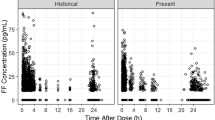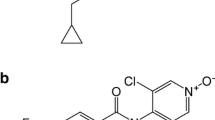Abstract
Background Theophylline has a narrow therapeutic range and large interindividual variability in blood levels, so a thorough understanding of its pharmacokinetic characteristics is essential. Population pharmacokinetic (PPK) approaches could achieve it and many PPK studies of theophylline have been reported in infants. However, none was conducted in Chinese adults and none has explored the effect of CYP1A2 genotypes on the PPK characteristics of theophylline in adults. Objective To evaluate the PPK characteristics of theophylline and to assess the possible influence of covariates, including CYP1A2 genotypes, on theophylline clearance in Chinese adult patients. Setting The study is conducted at the department of respiration in Zhujiang Hospital, Guangzhou, China. Methods Theophylline concentrations were obtained from eligible patients and were measured by high performance liquid chromatography. The polymorphisms of − 3860G > A, − 163C > A, C5347T (CYP1A2*1B) and G-3113A were genotyped using a direct sequencing method. Then, CYP1A2 genotypes, age, fat-free mass (FFM) and other covariates were used to develop a PPK model by NONMEM software. Bootstrap analysis was used to asses the accuracy and prediction of the PPK model. Main outcome measure The concentration and clearance of theophylline. Results A total of 134 theophylline concentrations from 95 patients were obtained. The final model was as follows: CL/F(L/h) = 4.530 × (FFM/56.1)0.75 × 0.713CYP1A2*1B, the inter-individual variability in clearance/bioavailability (CL/F) was 44.0%, and the residual variability was 9.8%. The final model was proved to be reliable by bootstrap analysis. Conclusion Theophylline clearance was significantly associated with FFM and CYP1A2*1B genotypes in Chinese adult patients.



Similar content being viewed by others
References
Barnes PJ. Theophylline. Am J Respir Crit Care Med. 2013;188(8):901–6.
Pal S, Khan K, China SP, Mittal M, Porwal K, Shrivastava R, et al. Theophylline, a methylxanthine drug induces osteopenia and alters calciotropic hormones, and prophylactic vitamin D treatment protects against these changes in rats. Toxicol Appl Pharmacol. 2016;295:12–25.
Ito K, Lim S, Caramori G, Cosio B, Chung KF, Adcock IM, et al. A molecular mechanism of action of theophylline: induction of histone deacetylase activity to decrease inflammatory gene expression. Proc Natl Acad Sci USA. 2002;99(13):8921–6.
Cosio BG, Soriano JB. Theophylline again? Reasons for believing. Eur Respir J. 2009;34(1):5–6.
Ford PA, Durham AL, Russell RE, Gordon F, Adcock IM, Barnes PJ. Treatment effects of low-dose theophylline combined with an inhaled corticosteroid in COPD. Chest. 2010;137(6):1338–44.
Otero MJ, Buelga DS, Vazquez MA, Barrueco M, Dominguez-Gil A. Application of population pharmacokinetics to the optimization of theophylline therapy. J Clin Pharm Ther. 1996;21(2):113–25.
Han K, Pillai VC, Venkataramanan R. Population pharmacokinetics of cyclosporine in transplant recipients. AAPS J. 2013;15(4):901–12.
Marsot A, Boulamery A, Bruguerolle B, Simon N. Population pharmacokinetic analysis during the first 2 years of life. Clin Pharmacokinet. 2012;51(12):787–98.
Thomas G, Koen R, Houze P, Lagier G, Gervais P. Steady-state population pharmacokinetics of sustained release theophylline in adult asthmatic patients. Fundam Clin Pharmacol. 1991;5(7):611–9.
Li Z, Chen G. Evaluation of theophylline population pharmacokinetics in adult hospitalized patients using NONMEM analysis. Zhongguo Yao Li Xue Bao. 1994;15(3):267–70.
Yano I, Tanigawara Y, Yasuhara M, Mikawa H, Hori R. Population pharmacokinetics of theophylline. I: intravenous infusion to children in the acute episode of asthma. Biol Pharm Bull. 1993;16(1):59–62.
Tanigawara Y, Komada F, Shimizu T, Iwakawa S, Iwai T, Maekawa H, et al. Population pharmacokinetics of theophylline. III. Premarketing study for a once-daily administered preparation. Biol Pharm Bull. 1995;18(11):1590–8.
Yim EY, Kang HR, Jung JW, Sohn SW, Cho SH. CYP1A2 polymorphism and theophylline clearance in Korean non-smoking asthmatics. Asia Pac Allergy. 2013;3(4):231–40.
Rasmussen BB, Brix TH, Kyvik KO, Brosen K. The interindividual differences in the 3-demthylation of caffeine alias CYP1A2 is determined by both genetic and environmental factors. Pharmacogenetics. 2002;12(6):473–8.
Nakajima M, Yokoi T, Mizutani M, Kinoshita M, Funayama M, Kamataki T. Genetic polymorphism in the 5′-flanking region of human CYP1A2 gene: effect on the CYP1A2 inducibility in humans. J Biochem. 1999;125(4):803–8.
Obase Y, Shimoda T, Kawano T, Saeki S, Tomari SY, Mitsuta-Izaki K, et al. Polymorphisms in the CYP1A2 gene and theophylline metabolism in patients with asthma. Clin Pharmacol Ther. 2003;73(5):468–74.
Yoon Y, Park HD, Park KU, Kim JQ, Chang YS, Song J. Associations between CYP2E1 promoter polymorphisms and plasma 1,3-dimethyluric acid/theophylline ratios. Eur J Clin Pharmacol. 2006;62(8):627–31.
Anderson BJ, Holford NH. Mechanistic basis of using body size and maturation to predict clearance in humans. Drug Metab Pharmacokinet. 2009;24(1):25–36.
Ette EI. Stability and performance of a population pharmacokinetic model. J Clin Pharmacol. 1997;37(6):486–95.
Rugelj N, Trobec KC, Pislar M, Brguljan PM, Kosnik M, Mrhar A. Evaluation of theophylline therapeutic drug monitoring service. Zdrav Vestn. 2015;2015(84):191–202.
Driscoll MS, Ludden TM, Casto DT, Littlefield LC. Evaluation of theophylline pharmacokinetics in a pediatric population using mixed effects models. J Pharmacokinet Biopharm. 1989;17(2):141–68.
Robson RA, Miners JO, Matthews AP, Stupans I, Meller D, McManus ME, et al. Characterisation of theophylline metabolism by human liver microsomes. Inhib Immunochem Stud Biochem Pharmacol. 1988;37(9):1651–9.
Moller SE, Larsen F, Pitsiu M, Rolan PE. Effect of citalopram on plasma levels of oral theophylline. Clin Ther. 2000;22(12):1494–501.
Gu L, Gonzalez FJ, Kalow W, Tang BK. Biotransformation of caffeine, paraxanthine, theobromine and theophylline by cDNA-expressed human CYP1A2 and CYP2E1. Pharmacogenetics. 1992;2(2):73–7.
Wang L, Hu Z, Deng X, Wang Y, Zhang Z, Cheng ZN. Association between common CYP1A2 polymorphisms and theophylline metabolism in non-smoking healthy volunteers. Basic Clin Pharmacol Toxicol. 2013;112(4):257–63.
Takata K, Saruwatari J, Nakada N, Nakagawa M, Fukuda K, Tanaka F, et al. Phenotype-genotype analysis of CYP1A2 in Japanese patients receiving oral theophylline therapy. Eur J Clin Pharmacol. 2006;62(1):23–8.
Uslu A, Ogus C, Ozdemir T, Bilgen T, Tosun O, Keser I. The effect of CYP1A2 gene polymorphisms on Theophylline metabolism and chronic obstructive pulmonary disease in Turkish patients. Bmb Rep. 2010;43(8):530–4.
Bernauer U, Heinrich-Hirsch B, Tonnies M, Peter-Matthias W, Gundert-Remy U. Characterisation of the xenobiotic-metabolizing Cytochrome P450 expression pattern in human lung tissue by immunochemical and activity determination. Toxicol Lett. 2006;164(3):278–88.
Fukami T, Nakajima M, Sakai H, Katoh M, Yokoi T. CYP2A13 metabolizes the substrates of human CYP1A2, phenacetin, and theophylline. Drug Metab Dispos. 2007;35(3):335–9.
Zhang ZY, Kaminsky LS. Characterization of human cytochromes P450 involved in theophylline 8-hydroxylation. Biochem Pharmacol. 1995;50(2):205–11.
Faber MS, Jetter A, Fuhr U. Assessment of CYP1A2 activity in clinical practice: why, how, and when? Basic Clin Pharmacol Toxicol. 2005;97(3):125–34.
Plowchalk DR, Rowland YK. Prediction of drug clearance in a smoking population: modeling the impact of variable cigarette consumption on the induction of CYP1A2. Eur J Clin Pharmacol. 2012;68(6):951–60.
Yano I, Tanigawara Y, Yasuhara M, Okumura K, Kawakatsu K, Nishimura K, et al. Population pharmacokinetics of theophylline. II: intravenous infusion to patients with stable chronic airway obstruction. Biol Pharm Bull. 1993;16(5):501–5.
Au WY, Dutt AK, DeSoyza N. Theophylline kinetics in chronic obstructive airway disease in the elderly. Clin Pharmacol Ther. 1985;37(4):472–8.
Landay RA, Gonzalez MA, Taylor JC. Effect of phenobarbital on theophylline disposition. J Allergy Clin Immunol. 1978;62(1):27–9.
Antoniou T, Gomes T, Mamdani MM, Juurlink DN. Ciprofloxacin-induced theophylline toxicity: a population-based study. Eur J Clin Pharmacol. 2011;67(5):521–6.
Acknowledgements
The authors thank the physicians for their work and the patients for their participation.
Funding
This research was supported by the National Natural Science Foundation for Young Scientists of China (No. 81302846).
Conflicts of interest
The authors declare no conflicts of interest.
Author information
Authors and Affiliations
Corresponding authors
Additional information
Yanjiao Ma and Ling Xue are contributed equally to this work.
Rights and permissions
About this article
Cite this article
Ma, Y., Xue, L., Chen, X. et al. Population pharmacokinetics of theophylline in adult Chinese patients with asthma and chronic obstructive pulmonary disease. Int J Clin Pharm 40, 1010–1018 (2018). https://doi.org/10.1007/s11096-018-0636-6
Received:
Accepted:
Published:
Issue Date:
DOI: https://doi.org/10.1007/s11096-018-0636-6




